Improving Enterprises With Video-on-Demand Services
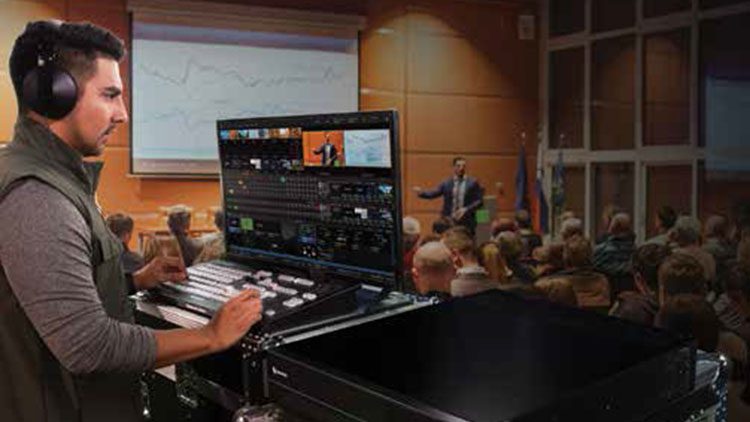
It’s more good news for the bottom line. Enterprises can realize savings by way of live streaming and video-on-demand distribution for training and internal communications.
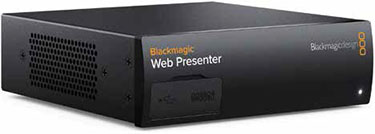
The Blackmagic Web Presenter makes any SDI or HDMI video source appear as a USB webcam for higher quality web streaming.
With the ability to live stream webinars, sales meetings, and trainings, etc., businesses can benefit immensely by saving money on things like travel costs for employees and venue space rental fees, said Bob Caniglia, director of sales operations, Blackmagic Design. “There are inexpensive, high-quality streaming products on the market today, so with an internet connection, live streaming is a completely viable option for any business looking to save money. Furthermore, businesses can record these meetings and trainings and then archive them, so they are available for use over and over again, saving money yet again because businesses don’t need to invest additional time and costs as meetings continue to be held and as employees continue to be trained. A small investment in live streaming and video recording products will pay for itself many times over.”
The first benefit to using video and in-house production is speed, noted Will Waters, director of product marketing, NewTek. “Using live-streamed video provides an incredibly effective way to address internal concerns and external issues quickly, easily, and with flexibility. The response time to communicate new product development, or for rolling out a new business strategy, is reduced. Video has a real benefit of grabbing attention when the content is engaging, compared to oral communication or written text. ‘Time is money’ translates in full detail.”
There’s the additional benefit of controlling both the brand and the message. “No one understands a business better than itself,” he added. “Delivering communication internally via video, and doing that via in-house methods, results in a solid message that is consistent from top to bottom. Consistency throughout the organization then translates to team building and interaction while reducing change management costs. And we’re seeing companies replacing their enormously expensive annual or semi-annual sales team events with more frequent video programming at a fraction of the cost.”
Training is another area where effective use of video can be very powerful. Waters pointed to the Whirlpool Corporation as a good example. “They have a broad set of global brands and products of evolving character and complexity,” he said. “Features and benefits of new product models designed to appeal to today’s consumers are being introduced regularly. Conveying detailed selling points across the enterprise can often be complex and difficult to communicate to a broad set of salespeople. To do this cost effectively and efficiently, Whirlpool routinely creates video programming about new products that is not only informative, but great looking and compelling to watch. Programming that looks and feels like a television show that draws you in, holds your attention, and gets the message across. These videos are available on demand to sales staff wherever they may be, and allows them to instantly message their sales force in a cohesive, compelling, and powerful way that is incredibly cost effective.”
Time Is on Your Side
A daily selection of the top stories for AV integrators, resellers and consultants. Sign up below.
Enterprises stand to gain obvious logistical and time savings benefits not only from live streaming training content and internal communications, but by going one step further to archive that content for employee consumption on demand, noted Bryce Button, director of product marketing, AJA Video Systems. “When enterprises opt to live stream training seminars and make them available on demand, they can minimize expenses because employees can tune in from their desks or remote locations, eliminating the typical travel logistics and cost considerations associated with gathering everyone together for an in-person seminar.”
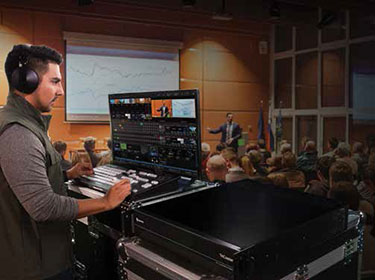
The NewTek TriCaster is a software-driven live production system that integrates all the traditional tools required in video production into a single system.
Time management is another huge factor, he added, especially for enterprises that operate in more than one location. “Most often, it takes less time, effort, and resources to coordinate a live-streamed seminar or communication to a group of employees than to arrange a series of group meetings for employees at various offices. With on-demand content, employees can view the content when their schedule allows. It can be particularly valuable to employees who travel frequently or are based in a different time zone. For employees who might want a refresher, the content is easy to access.”
Overall, there are huge efficiency savings to be had, Button said. “As the quality of available technology continues to advance, nearly rivaling that of broadcast, it’s becoming easier to show more details in these sort of training and internal communication initiatives via a presentation or computer whiteboard that can also be integrated into a streaming device. For example, our ROI Mini-Converter allows you to take content straight out of the presenter’s computer, and zoom in on particular areas, an added benefit for streaming.”
One Size Fits All
No matter the size of the enterprise, most employees have ready access to a decoder—a computer, tablet, or smartphone are all examples of devices with decoding capabilities, explained Ron Berty, business development manager, Matrox Graphics.
“This constant access empowers the user to stay connected, as well as providing the company with amazing training and communications opportunities with some major cost-cutting possibilities. The simple logistics of fitting a company’s worth of people in a single room is difficult at best. We work with a company that seeks to train their 15,000-plus employees simultaneously. However, moving them to a single location would require the rental of a stadium. By virtualizing the training to a streamed event, the facilities cost is nonexistent or severely reduced for just a subset of these people.”
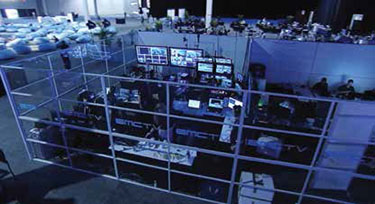
EMC, a multinational data storage/cloud computing company, chose the NewTek TriCaster to ramp up its internal and external video communications without the need to ramp up extraneous video staff.
Berty noted the costs associated with getting people to an event. “One is the travel cost, with the time traveling and the means of conveyance both having a price tag. As well, there is the opportunity cost of time spent away from revenue-generating activities. Instead of a salesperson coming ‘off the road’ to take in-person training, streamed or on-demand training could be as easy as pulling over at a pit stop or reviewing in a hotel room, and then continuing on with the activities of the day.”
Lastly, getting employees up to speed can drive more revenue sooner. With streaming, training is immediately available, it can be edited immediately, it can be updated with new information immediately, and it can be used as on-demand training for new employees instead of having them wait until the next in-person session.
Camera-Ready Clients
High-quality productions will encourage people to use video more, while poor-quality video and audio will discourage use, Caniglia said. “But high quality doesn’t have to mean expensive or complicated. There are affordable, user-friendly cameras available today that will produce broadcast-quality video, and streaming products that allow businesses to use quality HDMI and SDI cameras and audio equipment instead of low-resolution webcams. By keeping video looking and sounding professional, businesses can capitalize on the benefits of streaming and video on demand while providing an experience that is just as good as the real thing.”
Businesses are realizing video production is less intimidating and more cost-effective than any time previous, Waters noted. “No longer are conventional racks of gear and highly specialized personnel required to switch, mix, add graphics, record, and stream. Corporate entities can have production happening at the desktop level if desired, which then can scale to any level as the demand requires.”
For example, he continued, EMC, a multinational data storage/cloud computing company (recently acquired by Dell), chose the NewTek TriCaster to ramp up its internal and external video communications without the need to ramp up extraneous video staff. “The TriCaster is a software-driven live production system that integrates all the traditional tools required in video production into a single system. This flexible solution built on a software model can then scale with the business as the need arises. It is also relatively easy to learn how to use. For example, many middle and high schools across the U.S. have students running TriCasters. Businesses can grow into the advanced features built into TriCaster as they become more comfortable with the basics.”
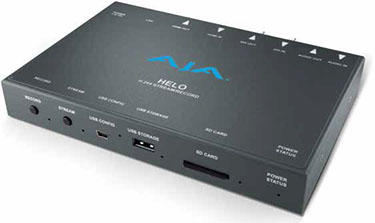
Using an HDMI connection, enterprises can feed camera signals into low-cost streaming capture devices like AJA’s U-TAP HDMI device with a USB connection to the computer carrying both power and video/audio or through a standalone streaming device like AJA HELO.
And assuming we’re not talking hair and makeup, effectively, the old rule of “garbage in, garbage out” applies here, Button said. “Luckily today there is a range of cameras available at affordable price points that offer stellar imagery from the outset. Even if the final output is HD, shooting in 4K or Ultra HD can help enhance the image quality. The latest cameras also offer a consumer connection in terms of HDMI, which opens up affordable streaming options. Using an HDMI connection, enterprises can feed camera signals into low-cost streaming capture devices like AJA’s U-TAP HDMI device with a USB connection to the computer carrying both power and video/audio or through a standalone streaming device like AJA HELO. For companies with the budget and resources to match, higher-end SDI-based cameras are also good option. And, with the advent of HDMI 2.0, which supports high frame rates, the quality of image that enterprises can achieve will only get better, ensuring animations and motion activity will translate into a more smoothly encoded signal to be streamed.”
Also key, Berty explained, is not to be camera-ready, but to use the camera(s) for all they are worth. “The camera is present, real time, and local. Cameras allow us to capture the present and encode it [to be] available whenever, wherever, and forever.

The Matrox Maevex 6150 quad 4K enterprise encoder appliance offers users up to quad 4K simultaneous streaming and recording—allowing for transmission of numerous streams of video and desktop content over 1Gb ethernet networks.
“There are already encoder appliances and add-in boards on the market that offer simultaneous streaming and recording capabilities, making the simultaneous capture and distribution of training easy,” he continued. “However, there are products coming to market from Matrox that can offer multiple simultaneous streams and recordings. This is hugely important. Events like this cannot happen twice, so in case of a network failure, a local recording guarantees the possibility of later distribution.
“Secondly, an RTSP/MPEG-TS stream can stream to the local network, facilitating a live event that reaches beyond the training room and across the whole LAN/company premises,” he added. “Finally, simultaneous RTMP streaming means that the stream can also be pointed to the cloud, and distributed to the external employees who may not work in the local area networked environment, as well as to customers and clients. This can be offered as a service to educate, to drive revenue, and to enhance retention through involvement. The simultaneous recorded video can also then be edited and made available on demand as a tool or service for review or new employee or customer training. Again, it’s not just about now, it’s about whenever, wherever, and forever.”
Karen Mitchell is a freelance writer based in Boulder, CO.
Bottom Line
When making the pitch for live streaming to an enterprise business, stress how it will help things run more smoothly within their organization—which will ultimately lead to savings.
“Enterprise businesses are always looking for ways to streamline and increase operational efficiency,” said Will Waters of NewTek. “Using video to communicate internally creates opportunity to optimize business communications and has a direct impact on the bottom line long term.”
